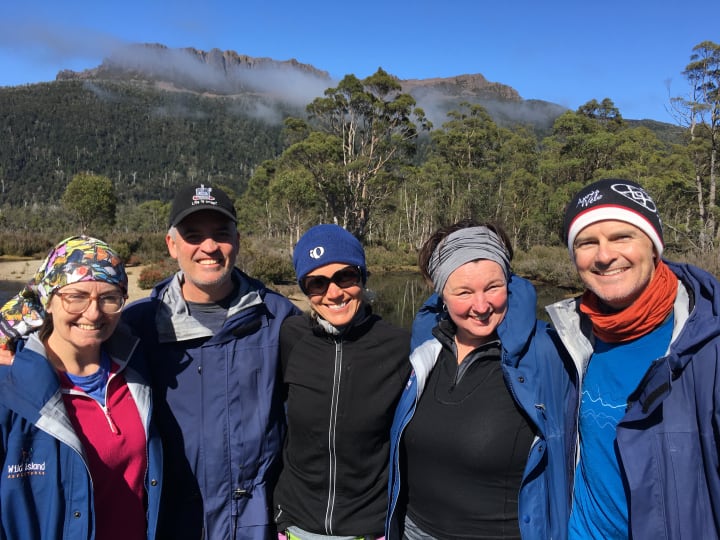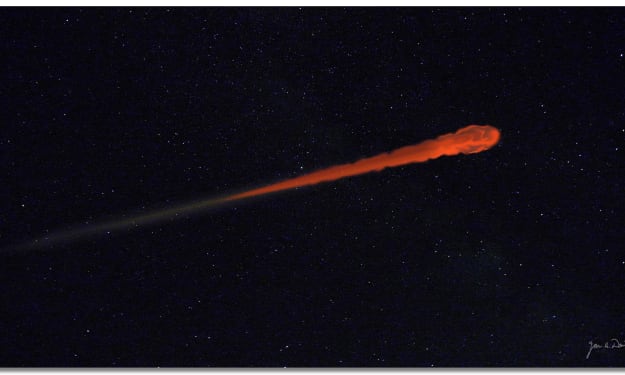Gear for the Overland Track
10 favourite items for surviving the Tasmanian wilderness

I walked Tasmania's Overland Track just before the COVID-19 lockdown. At the end of my solo journey – when I arrived at Narcissus Hut to radio the Lake St Clair ferry operator – a park ranger was attaching a public warning sign to the door. All public huts were closed due to the virus.
With its dark rainforests, gnarly slippery tree roots, knee-deep bogs, exposed alpine moorlands, endless upstream climbs, colossal boulders, high winds and bucketing rain, you need to come prepared. The weather can change quickly and dramatically and there is no mobile phone coverage (or charging facilities).
The discomfort of a fully loaded pack, and the leeches and the tiger snakes, can create some fragile moments. What you'll really remember are the camping hacks, chocolate blocks and whiskey conversations shared with fellow hikers on the trail.
What to pack
The checklist of essential items compiled by Tassie's Parks & Wildlife Service is extensive and, at first glance, intimidating. To keep costs and weight to a minimum, I asked my experienced hiker friends to help kit me out with compact, lightweight and waterproof clothing and gear for this rather spur-of-the-moment wilderness expedition.
Once I'd added a personal locator beacon ($40 hire fee), 2L of water and a fuel canister ($14) at the Cradle Mountain Visitor Centre, I reckon my pack starting weight was around 16kg.
Rather than listing everything you need for walking the Overland, I've picked a few of my favourite must-haves, suitable for self-guided hikers who will carry all their own gear and sleep in a tent or the public huts.
Wherever possible, I support outdoor brands that are working to minimise their footprint and produce products more sustainably.
What I wished I'd packed for my Overland adventure is another story!

1. Hiking boots
The 65km Overland Track stretches north to south from Cradle Mountain to Lake St Clair through the rugged Tasmanian highlands. If you want your feet to stay dry and keep yourself upright, supportive waterproof boots with good traction are essential.
I recommend Salomon Women's X-Ultra Mid GTX boots (RRP $330) because they are lightweight (420 grams) and springy, and even in the wet they held my foot comfortably in place when I was walking downhill (saving my toenails). They come up fairly high around my ankle but I needed the extra support because I was carrying a heavy load.

2. Canister stove
Fires aren’t allowed on the Overland Track, so you'll need to carry a compact, lightweight stove that is reliable, stable and easy to use. I didn't fancy cooking; I just needed hot water to prepare my coffee, tea, porridge, soups and dehydrated meals in the huts.
I recommend the Jetboil stove (RRP $110) because it boils water in a lightning-quick 100 seconds! MSR pocket rocket canister stoves (RRP $95) are also very popular on the OT and have been an institution in the bushwalking world for decades.
You can pre-order and collect fuel canisters from any of the numerous bus transfer companies that take you to the Cradle Mountain trail head. At the end of my hike I gave my half-empty canister to a local hiker at the Lake St Clair Visitor Centre.

3. Walking poles
I don’t have dodgy knees but I wanted to keep my balance trudging through all the mud and puddles on the trail.
I recommend Leki Trail anti-shock walking poles (RRP $135) because they provided welcome relief on the rugged, steep sections, especially on the longer walking days when I became tired and wobbly. They are lightweight, easy to adjust (twist-lock mechanism) and the grips are comfortable. When I wasn't using them on the boardwalks they fitted neatly into my backpack.
https://www.leki.com/us/trekking/poles/

4. Sleeping bag
Almost half of the Overland Track is above 1000m in elevation on exposed plateaus in a remote area (it can snow any time of year), so a lightweight and compressible sleeping bag is essential. The temperature rating is important, but the better it fits, the warmer it will be.
I recommend the Deuter Orbit +5° ‘SL’ model (RRP $170) because it's shorter than the regular model and ideal for women up to 175cm tall. The ‘mummy’ shape makes it warm as well as easy to pack. It’s super snug thanks to the extra warmth of the fluffy fleece inner and the contoured hood, with a draw cord that is easy to use even in the dark.

5. Headlamp
You need a good headlamp to find your way around the huts and campsites after dark.
I recommend the Knog Bandicoot KS silicone USB rechargeable lamp (RRP $60). Weighing just 60 grams, it was less bulky and much more comfortable than the traditional headlamps I've used. It’s waterproof, adjustable, super bright, fits snuggly and didn't get tangled in my hair.

6. Long-sleeve top
Getting your base layers right is essential. Whether you go with synthetic fabrics or natural, you need them to wick well.
I recommend the Icebreaker 260 tech long-sleeve top ($150) because it is exceptionally soft and warm, and the seams didn’t rub when I walked for many, many hours. Being Merino wool, I wore it every day for a week without it getting whiffy (there are no showers on the route but there are a couple of divine swimming holes), plus it offered some wind-resistance when I wore it on its own.

7. Waterproof jacket
You don't want to be that trekker on the trail who is shivering and cold, so choose your layers carefully. Pack a lightweight waterproof jacket that is long enough to cover your bum. A storm flap over the zip is also a good idea.
I recommend a Berghaus jacket (RRP $145) with an adjustable hood that holds well in the wind – you'll need it when you are walking across the exposed plateaus in the driving rain! It's breathable and loose enough to layer clothing underneath. Berghaus has created some extremely technical, protective, functional and costly waterproof jackets. This is an affordable option that works really well.

8. Stuff sacks
Packing efficiently is an art that I’m still mastering. I used to pack randomly but I’ve changed my style to ensure comfort and stability while I walk.
I recommend Kathmandu stuff sacks as an easy way to get organised. These handy lightweight drawstring storage bags (RRP $14) are well made with strong (washable) fabric. They are great for packing down your gear into your backpack and much better than plastic bags. The capacity of the medium is 7L.

9. Sleeping pad
Whether you choose to sleep in the huts with the snorers or on the draughty tent platforms under the stars, you need a really good sleeping pad. After a hard day on the trail you'll want a good night’s sleep and for your muscles to relax.
I recommend the Thermarest ProLite Self-Inflatable Sleeping Pad (RRP $240) – ultra-compact, light, and with a unique diagonal-cut foam that provides efficient insulation. It inflates quickly with the twist of the valve and is fairly comfortable for a side-sleeper like me.
10. Rain pants
You'll experience heavy rain on the Overland Track, if not sleet or snow. Rain pants are invaluable. Choose waterproof, breathable material, with Velcro around the ankles so that you can put them on/take them off without removing your hiking boots.
I recommend a less fancy low-cost polyester fabric (not Gore-Tex). My Crane Packable Rain Pants ($25) kept my legs bone dry.

About the Creator
Samantha McCrow
Sam is a writer, hiker, ocean swimmer, trail runner, volunteer lifesaver and adventure traveller based in Melbourne, Australia. She loves authentic connections and exploring outdoors.






Comments
There are no comments for this story
Be the first to respond and start the conversation.